Content [show]
The first association that arises at the mention of buttercups is the sunshine and freshness of greenery, which give a special spring mood. That is why this culture is popular among flower growers. Florists often use potted ranunculus to decorate living spaces and ceremonial halls.
What does ranunculus look like and reproduce?
Ranunculus is a perennial herb of the buttercup family. Asia Minor is considered his homeland. The flower has several simpler names: Asiatic buttercup, adonis, fierce color.

Lat. Ranunculus
The cultivation of buttercups has been known since the 16th century. This culture was spread almost all over the world. It was cultivated in Asia, in Europe and northeast Africa. Therefore, ranunculus has many additional definitions.
This flower was also known in antiquity, which is confirmed by the numerous mentions of buttercup in myths and legends. Recently, the popularity of buttercups has been increasing. They are increasingly used not only as a decorative decoration, but also when drawing up flower bouquets and compositions.
Translated from Latin, ranunculus means "froglike". The flower got this name because in natural conditions it grows near the reservoir or directly in them.
In nature, there are more than 500 species, but only undersized hybrids are grown at home. They have large flowers and a wide leaf blade. Lush and long flowering. Rosettes on the bush bloom continuously for 1-2 months. Usually in June-July.
Reproduction of ranunculus of decorative varieties is carried out in two ways:
- Seeds
- Bulbs
To germinate seeds, you must first soak them in water for 2 hours. Then they are planted in a prepared soil substrate to a depth of 3-4 cm. With the help of glass or oilcloth, a greenhouse effect is created in the flowerpot. The soil is periodically moistened with a spray bottle. After the sprouts appear, the pot opens. Transplanting and diving of seedlings is carried out after the appearance of 5-6 leaves. This method is long and laborious and often does not bring the expected result.
Ranunculus propagates more efficiently by bulbs. The plant annually gives an increase of 5-7 young shoots.They are separated and transplanted into a separate container. The plant takes root well and blooms quickly. But often there is a shredding of the color rosette.
Experienced florists recommend purchasing new planting material in nurseries every year. Such plants develop much better, their flowering occurs earlier.
Owners of ranunculus, regardless of its type, must take into account the fact that the plant sap is poisonous. Therefore, when caring for him, you should wear protective gloves, and also put the flowerpot out of the reach of children and pets.
How to grow ranunculus in a flower bed
In open ground, tubers are planted in mid-April. The top layer of the soil should warm up by 5-8 degrees. Before planting the bulbs, preliminary preparation of not only the soil, but also the planting material is carried out.

Lovely ranunculus plant
The soil in the landing hole should be light and loose. For this, it is mixed with river sand and peat. You can enrich the soil with nutrients using rotted manure. Do not add fresh organic matter to the hole, as this will lead to the death of the tuber.
10-12 hours before planting, it is recommended to place the bulbs in clean water. 1-2 hours before disembarkation, a root formation stimulator is added to the vessel.
How to properly plant ranunculus in open ground:
- In the prepared place, a hole is dug 25-30 cm deep, 15-20 cm in diameter
- A drainage layer is poured at the bottom, its height is 7-10 cm
- The depression will be filled with soil mixture with a layer of about 10 cm
- A tuber is placed in the filled hole, sharp tips down
- Planting depth of the bulb - 7 cm
- After, the hole is filled with the remaining soil to the brim, while it is neatly compacted around the tuber
- Watering is carried out with clean water at room temperature
- The hole is mulched with wood chips or clean soil
- If several bushes are planted at the same time, a distance of 12-15 cm is maintained between them
For greater decorative appeal, florists recommend planting buttercups in small groups. This can be a single bush or trench planting. To give brightness and contrast, flower growers often plant several types of plants with different sizes and shades of flowers in the same flower bed.
Not only high-quality planting material and proper planting, but also proper care for ranunculus allows you to get a bright living carpet with luscious greenery. After planting the tubers in the open ground, the flower must be regularly:
- To water
- Feed
- Treat with agents against harmful insects and diseases
Rununculus does not like transplants. Therefore, when forming a flower bed, you should find a slightly shaded place for it on the south side. If you plan to constantly change the place of formation of the flower bed, it is better to grow the flower in a pot and, if necessary, simply rearrange it. Buttercups in a flowerpot grow well and bloom indoors. Therefore, this method of growing also allows you to decorate your home or workplace with bright colors.
Growing ranunculus in a pot: planting and care
A flower in a flowerpot can be used as an interior decoration, or to decorate balconies and loggias with it. Ranunculus in such conditions develops no worse than when grown outdoors.
At home, varieties are planted with short stems and multiple large leaves. It is also possible to cultivate hanging species. Regardless of the option chosen for landing, you must:
- Buy bulbs
- Buy a suitable flowerpot
- Prepare potting mix and drainage

Multi-colored bloom of bright ranunculi
You can buy high-quality planting material exclusively in specialized stores. At these points of sale, the bulbs are stored under appropriate conditions. This allows you to maintain their germination. Do not buy bulbs at fairs or markets. It is important to examine them carefully when buying.Tubers should be dense, their surface without mechanical damage and traces of damage by pests. Also, the presence of mold, dried or rotted areas is unacceptable.
At home, flower growers recommend planting the plant in a group, and not one at a time. Therefore, when choosing a flowerpot, you should give preference to wide oblong pots or decorative boxes. The material of their manufacture is selected depending on the purpose of growing. A ceramic or glass flowerpot with a wide drainage hole is suitable for decorating a room. Its diameter is at least 15-20 cm. If it is necessary to grow the bulb before planting in open ground, it is permissible to use a plastic container.
The soil for the flower should be loose. Ready-made mixtures based on peat are suitable. Broken shards of ceramic flowerpots can be used as drainage. Expanded clay or eggshells.
Planting a ranunculus in a pot is carried out in the following way:
- The day before planting, the tubers are soaked in clean water
- Drainage is poured onto the bottom of the prepared flowerpot, a layer of 3-4 cm
- Then ¾ the flowerpot is filled with soil
- Place the onions in the pot with the sharp side up.
- Then the earth is filled up and watering is carried out
- The tops of the tubers should slightly protrude from under the soil.
Growing a flower on a windowsill
Next, the flowerpot is placed on the windowsill on the south side. Caring for ranunculus at home is reduced to maintaining an average soil moisture and maintaining a temperature regime within 18 degrees.
The tubers should sprout within a few weeks. When the sprouts rise a few centimeters, the temperature in the room must be increased to 22 degrees. During the growing season, the flower is regularly fed with special fertilizers. Watering is carried out three times a week, the soil should be constantly slightly moist. Watering is reduced after the plant wilts.
The dormant period of a ranunculus grown in a pot lasts within 1-1.5 months. Preparation for it consists in transplanting tubers into a fresh soil substrate. Then the pot is placed in a shaded place with a temperature of 15-18 degrees.
Timeliness and proper care significantly affects the development and appearance of a flower. Therefore, adherence to the recommendations of florists is mandatory.
While watching the video, you will learn about growing ranunculus.
It is possible to grow ranunculus on your own at home. In order for the plant to be lush and blooming, it is important not only to properly care for it, but also to use high-quality planting material.
Have you noticed a mistake? Select it and press Ctrl + Enter to tell us.
Flowers and flower beds
Ranunculus, or Asiatic buttercup, is a charming flower that belongs to the Buttercup family. This plant is good both as a horticultural crop and as an indoor gardener.
Miniature flower beds in the garden with Asian buttercups will give you a lot of positive emotions. And at home, the beauty of blooming buttercups in the off-season will remind you of the onset of spring and summer.
Ranunculus at home
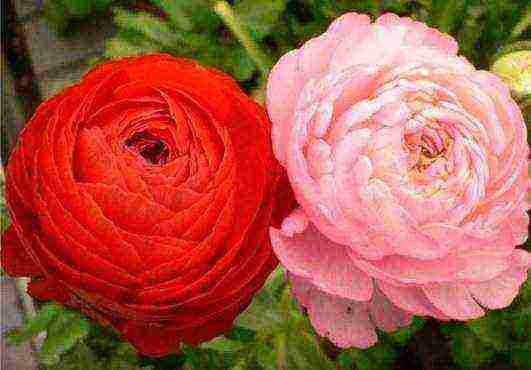
Most often, Asian buttercups are not house pets. Although this is completely undeserved. Gardeners, as a rule, do not deprive them of due attention. Although Ranunculus care is much more difficult than many other horticultural crops.
For indoor conditions, ranunculus is quite difficult to care for and unusual. However, those who decided to start it at home will have enough strength and patience to achieve a bright sunny flowering of this plant. To make the Asian buttercup look at home the most beautiful and bright, flower growers recommend planting it with a non-single plant, but with a group planting. This is not difficult to do. To do this, you need to buy a decorative box (which, by the way, you can decorate yourself) or just a wide pot.
In wide containers, you can plant Asiatic buttercup of one variety or several.A combination of a mixture of multicolored ranunculus will look just as beautiful as a combination of several monochromatic plants.
Undoubtedly ranunculus is the most suitable plant for gardening a balcony... And in the cold season, it will take a place in one of the rooms of your house and will give you a great mood and warm memories of the summer.
Description of ranunculus
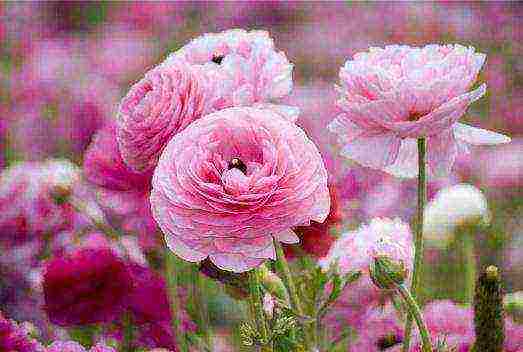
Ranunculus is an ornamental herb that blooms abundantly and beautifully. This genus is widespread throughout the globe. Currently, hundreds of species of ranunculus are known.
In the garden (as well as in the room) culture, there are a wide variety of Asian buttercups. By flower growers, they are divided into groups of annual, biennial and perennial species.
Ranunculus reaches a height of 20 to 80 cm, depending on the species. Ranunculus blooms in spring or early summer. But at home, you can, if desired, achieve flowering of the plant in the off-season (winter or autumn).
Ranunculus flowers can be simple, double or semi-double. Simple flowers resemble poppy flowers, double - flowers of miniature roses. The color of the flowers is very diverse. In addition, different varieties have different shades of well-known flowers. So far, only blue and blue buttercups have not been bred.
Different varieties and types of Asiatic buttercups bloom at different times. But most often the flowering period lasts from May to the summer months. There are species that bloom all summer.
Location in the ranunculus house

Ranunculus is a wonderful plant that is suitable for indoor conditions. This is a light-loving culture, so it feels great in sunny places. Will not harm ranunculus and slightly shaded place. Remember that in partial shade, the color of the flowers becomes more saturated and bright. And even flowering in partial shade lasts a little longer than usual.
The brightly colored ranunculus flowers cannot but arouse admiration. Therefore, choose the best places for it in your home. These are the places where the ranunculus will be most visible to you and your guests.
The Asian buttercup will perfectly decorate the interior of any living room. For the bedroom, it will also be a great addition. The nursery is just an amazing place for a green, brightly blooming pet. If you want, you can grow ranunculus in the kitchen, in the hallway, and anywhere! It is only important that light falls on the plant. The shadow is unbearable for him!
Ranunculus will feel great on the western and eastern windowsills of your home. If possible, place the Asiatic buttercup on the south window. This is the most favorable location for him. Do not drive the ranunculus deep into the room, because the lack, and even more so the lack of light, will have a detrimental effect on the development and flowering of the plant.
Read also:How to grow a datura?
Ranunculus: planting at home
- To plant ranunculus, you need to properly prepare the soil.If you decide to grow it at home, then any fertile, fertilized land will do. And if ranunculus grows in the garden, then mix pine humus with ordinary garden soil in a 2: 1 ratio. The same mixture can be great for growing ranunculus at home.
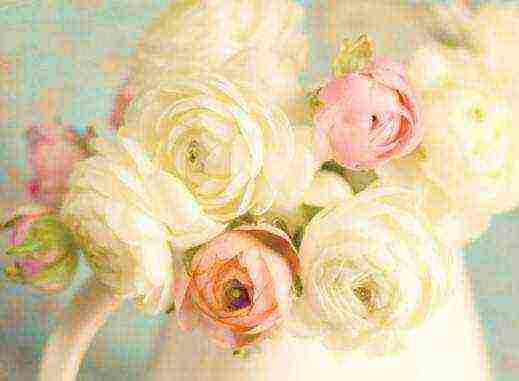
- Plant seeds are best planted in February - March. Disinfect the ground with a foundation solution before planting seeds.
- Seeds should be sown to a depth of 2-3 mm every 1-2 cm. The boxes should be deep enough. Then the planted seeds are watered and covered with foil.
- Be sure to place your plantings in a sunny place by the window.
- The temperature after sowing in the first 2 weeks should not exceed 12 ° C. This is the most optimal air temperature for sprouting.
- After 3 weeks, when small sprouts of Asian buttercups have already appeared, remove the film from the boxes. The air temperature should become higher, but not exceed 20 ° С -22 ° С.
- By mid-April, seedlings can be planted in the garden in flower beds or in separate pots for growing as indoor gardeners.
Read also: Ranunculus: planting and care
Ranunculus care at home
Ranunculus care is quite simple. This is the standard minimum for caring for your favorite indoor plants. It lies in the right conditions.

- Lighting - bright sunlight or partial shade.
- The temperature is moderate. During the flowering period, not lower than 18 ° C.
- Air humidity is moderate. It is useful to periodically arrange souls for the plant.
- Watering is moderate, regular, preferably top. Ranunculus loves moist soil. However, do not overwet it. The plant does not tolerate wet soil, it may die.
- Ranunculus propagates with the help of daughter tubers or seeds. Daughter tubers must be separated after digging and placed for the winter. They are stored until spring, then planted in the soil. Seed propagation is the most affordable and simple way to propagate the indoor culture of Asian buttercups.
- Transplant every spring if the plant is perennial. If it is a biennial, and even more so an annual, the transplant is excluded by itself.
Ranunculus is undemanding to the composition of the soil. However, it must be loosened periodically. This will prolong flowering and make it more abundant.
The Asian buttercup is extremely intolerant of stagnant water.

Fertilize not only during the flowering period, but also in the fall. A little bone meal is added in the spring, and compost in the fall. During the flowering period, they are fed with mineral fertilizers every 2-3 weeks.
Read also:
- How to care for a camellia?
- Alyssum: planting and leaving
- How to grow an orchid?
- How to grow syngonium?
Undoubtedly, ranunculus is the most charming plant to grow at home. It is beautiful in its simplicity and very undemanding to care for. Ideal for balconies landscaping. Ranunculus will worthily take a place in one of the rooms of your house.
Asiatic buttercup bloom will give you a great mood and remind you of the warm season. True, for this you will have to try: especially carefully follow the basic rules for caring for him and feed him well.
Ranunculus (Latin Ranunculus), the middle name is Asian buttercup (garden). Ranunculus translated from Latin means "frog", this name was given by the ancient Greek scientist Pliny, apparently due to the fact that the plant prefers swampy areas. In Italy, the plant is called "the golden buttons of the meadows." According to legend, ranunculus are stars turned into flowers by Jesus to present to the mother as a sign of love and respect.
Ranunculus belongs to the Buttercup family. Asia Minor is considered the homeland. There are more than 600 plant species, but only Asian ranunculus with several varieties is cultivated.
Reproduction of ranunculus nodules
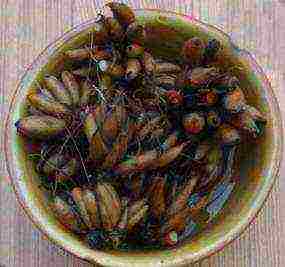
Ranunculus nodules photo
Most often, ranunculus is propagated by nodules. Choose the largest ones with about 4 "marigolds". Overdried or soft tubers are not suitable for planting.
Before planting, nodules should be held in water at room temperature for 10 hours. Then they are planted in a permanent place or in a container for preliminary germination.
Pre-germination will allow for an earlier flowering of the Asiatic buttercup:
- Take a flat, wide container, fill it halfway with nutrient soil, spread the nodules, sprinkle with substrate on top and pour water over it.
- Place the container in a cool place out of the reach of rodents. Roots and first seedlings should appear in two weeks.
- Sprouted tubers are planted to a depth of 6-7 cm, the distance between the holes is 10-15 cm.

How to plant ranunculus photo
Remember: non-sprouted nodules are planted with "claws" down, the top is a flat "bottom", to which the "claws" are attached.
Growing ranunculus from seeds

Ranunculus seeds photo
Seed propagation is a more laborious process.The seeds have an average germination rate. They can be purchased from a flower shop or assembled by yourself. Collect from the buds that bloom first. When they have faded, wrap the whisk with gauze to prevent ripened seeds from scattering on the ground. Pour them gently onto paper, dry, store until spring.
Sow Asiatic Buttercup for seedlings in mid-February. Fill the container with light fertile soil, scatter seeds over the surface of the soil, sprinkle with a layer of soil 1.5-2 cm thick. Cover the crops with foil or glass, place the container with crops in a lighted place, maintain the air temperature within 15-17 ° C.

Ranunculus from seeds on the 16th day after planting photo
Air the greenhouse, moisten the soil. Seedlings will appear in a couple of weeks - remove the shelter. With the appearance of a couple of leaves, plant young plants in separate containers. When warm weather sets in, plant in open ground. Flowering will come next year.
Planting and caring for ranunculus in the garden

How to plant ranunculus photo
With the onset of real heat without the threat of frost (from about mid-May), you can plant ranunculus tubers in open ground.
Choosing a site for planting an Asiatic buttercup
The flower grows normally under the sun, but in order for the inflorescences to be bright and the flowering to last, it is better to select an area with light shading. Protect from drafts.
Flower bed preparation
The soil needs a light, fertile, neutral reaction. A mixture of black soil with humus or peat is ideal. Loam categorically does not tolerate.
Dig up the soil, fertilize with compost, spill with a solution of foundation. A layer of sand should be laid at the bottom of the landing hole as drainage.
Preparation of buttercup tubers for planting and planting
- Before planting, the tubers must be kept in a humid environment for several hours - moss, wet sawdust, a damp sponge.
- You can soak in warm water or a slightly pink solution of potassium permanganate.
- When planting the tubers, place them down with their "beak", deepen into the soil by 5-8 cm.
- Observe a distance between landings of 10-15 cm.
- If after planting there is a possibility of frost or a sharp drop in temperature, cover the flower bed with non-woven material.
Watering
Water regularly, but in moderation. Loosen the soil periodically, remove weeds.
Top dressing
During the flowering period, apply top dressing every two weeks. Apply potash fertilizers, alternating with organics.
Preparing ranunculus for winter
With the onset of autumn, the tubers must be dug up. Do this as soon as the leaves turn yellow and dry. Cut the stems. Be very careful with tubers - they are fragile, they can break with careless movements. Dug up tubers about 30 min. hold it in the foundation solution, then dry it in a shaded place for 3 days. Wrap the nodules in a paper bag or dry moss, store until spring in a cool place (temperature 4-6º C) with good ventilation.
If in your area the air temperature does not drop below -7º C in winter, ranunculus tubers can be left to winter outdoors, but be sure to cover them with foliage or spruce branches.
Ranunculus at home

Ranunculus planting and care at home photo
Planting and leaving
For indoor cultivation, it is best to plant several ranunculus nodules in one container. Keep the tubers in a humid environment for a day. Take a large wide pot or decorate a box, place a drainage layer of expanded clay, crushed stone on the bottom, fill with fertile soil and plant the tubers. Deepen so that the top remains visible. Water well.
At first, keep the air temperature at 12ºC. When the flower grows a few centimeters, keep the air temperature in the range of 20-22ºC. During the flowering period, an air temperature of 18ºC is required.
Bright lighting is necessary.The best place will be the southern windows, but it grows quite normally on the western and eastern windows.
With the onset of warmth, it is not possible to take out fresh air.
Watering
Water regularly, in moderation. During flowering, watering will be stirred, and it is better to place a pot with a plant in shade. After wilting, reduce watering, stop altogether during the dormant period.
During the period of active growth with watering, mineral fertilizers should be applied occasionally.
Dormant period
Place in a shaded, cool place after flowering. When the leaves are dry, the stems should be cut off and the tubers transplanted into new soil. Store at an air temperature of 15-18 ° C. In April, shoots will appear, then return the flower to a bright place and take care of the usual way.
Diseases and pests of the Asiatic buttercup
Excessive moisture can rot the roots: mold will appear on the leaves, the ranunculus will drop the buds. Damaged parts must be removed. Loosen the soil, treat with fungicide, reduce watering.
Spider mites, aphids, thrips can settle on the plant. The pests infect the leaves, so their appearance will deteriorate. It is necessary to carry out an insecticide treatment.
Buttercup ranunculus in garden and interior design

Ranunculus in landscape design photo
The flower can be grown in gardens and under indoor conditions, cut flower stalks delight in a vase for about 2 weeks. Ranunculus is very often used in wedding bouquets.
The combination of different colors will be a wonderful decoration for flower beds. Decorate the borders with bright buttercups.
Types of ranunculus with photos and names
Ranunculus asiatic Ranunculus asiaticus

Asian ranunculus Ranunculus asiaticus photo
Herbaceous plant with a powerful stem 20-80 cm high. The root system is tuberous. The leaf plates are deeply dissected. Large (5-10 cm in diameter), consisting of many petals, the corolla has a variety of colors (except for the blue range). Flowers are semi-double, double, densely double, similar to roses.
Ranunculus Persian Ranunculus Persian
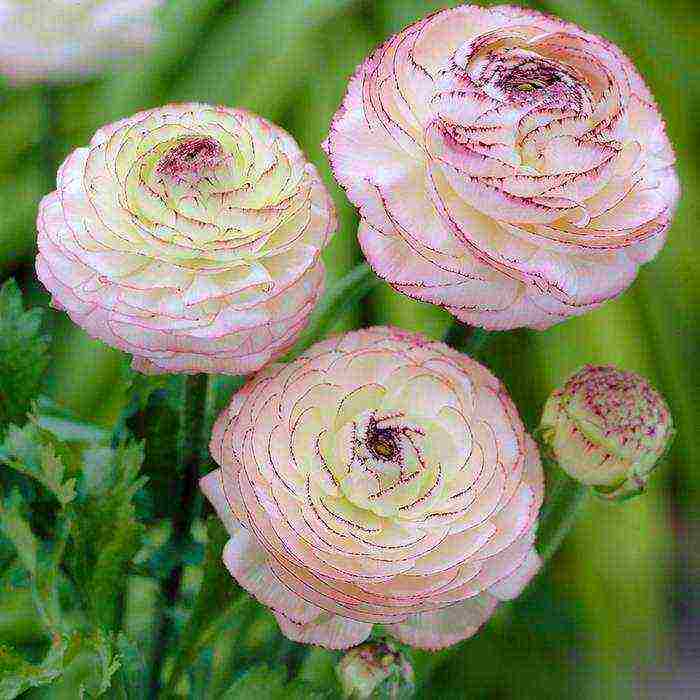
Ranunculus persian Ranunculus Persian photo
In appearance, the inflorescences are more like roses.
Ranunculus africanus Ranunculus africanus
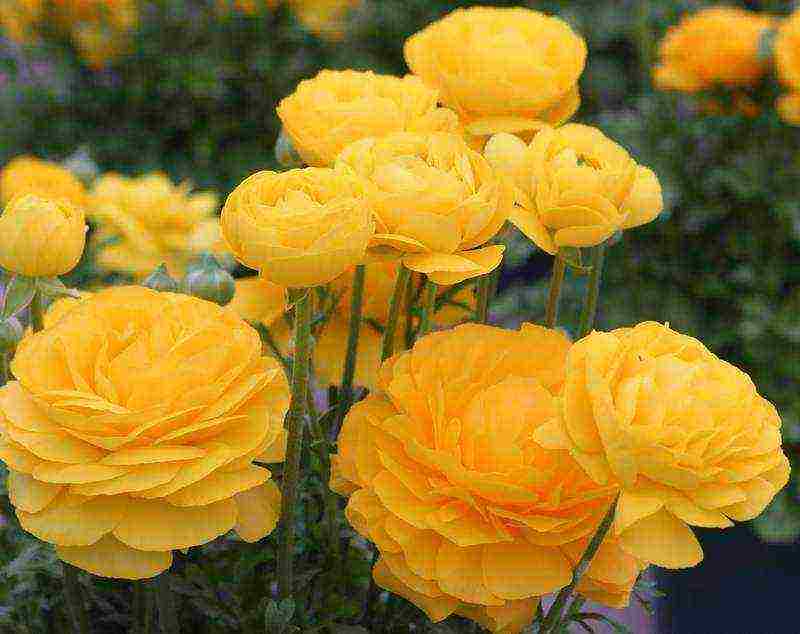
Ranunculus African Ranunculus africanus photo of flowers
The second name is turban - the inflorescences are very similar to peonies.
Ranunculus (Ranunculus) is also called the garden buttercup (Asian). The birthplace of such a plant belonging to the buttercup family is Asia Minor. The names of these flowers were given by the scientist Pliny, who lived in ancient times. From Latin ranunculus translates as "frog", the fact is that most species of such flowers prefer to grow in swampy places. In the 16th century, this plant was brought from Turkey to England and gained great popularity among flower growers there. However, since the end of the 19th century, it has lost its former popularity, but now these flowers are in increasing demand every year. At the moment, this genus unites more than 600 different species of ranunculus. If you cut a flower of such a plant and place it in a vase, then it will retain its freshness throughout the crescent. Italians call the garden buttercup "golden meadow buttons". There is a famous legend that Jesus turned small stars into buttercups and gave them to his mother as a sign of love and respect ...
Features of ranunculus

The Asian ranunculus is a pretty showy flower. It is used to decorate apartments and gardens, growing on balconies, terraces and living quarters. The height of the bushes can vary from 20 to 80 centimeters. Deeply dissected leaf plates are located on strong shoots. Rhizomes are presented in the form of tubers, shaped like the legs of geese. The shoots of this flower, along with the roots and leaves, are very similar to the dahlia. Very showy flowers can be semi-double, double and densely double. They differ in a variety of colors, but blue and blue flowers are not found.Their diameter varies from 5 to 10 centimeters, and they bloom gradually from May to August. At the very beginning of their opening, the flowers are similar to roses. And after full disclosure, they are very similar to terry poppies. Very often, pink ranunculus and white ranunculus are used when drawing up a bride's bouquet. But at the same time, do not forget that the juice of such a plant is poisonous.
Gardeners and florists are engaged in the cultivation of various species and varieties of Asian ranunculus. He, in turn, originally had 2 varieties, namely: turban or African ranunculus (Ranunculus africanus), the flowers of which are similar to peonies, as well as Persian ranunculus (Ranunculus Persian), its inflorescences have a certain resemblance to a rose.
Growing features
In order to grow beautiful flowers, you must adhere to certain rules in caring for them:
- While fertilizing the soil, you can burn the roots of the plant. In this regard, you need to opt for those fertilizers where vermicompost is available.
- The flower reacts extremely painfully to transplants, in this regard, it should be disturbed only if absolutely necessary.
- When a buttercup is in bloom, it needs limestone and potassium.
- To increase the duration of flowering, experienced growers advise to reduce watering and move the flower pot to a darkened place.
- When the leaf plates are completely dry, the plant's tubers must be dug up and stored for the winter, because the ranunculus is not frost-resistant.
- If you want to have a spectacular bouquet at home, then in one container you can plant several copies of such a plant at once, which will differ in the color of the flowers.
- Inflorescences that have begun to fade should be removed, in this case, new flowers will open faster. At the end of the summer period, the shoots must be cut to the ground.
How to plant in open ground
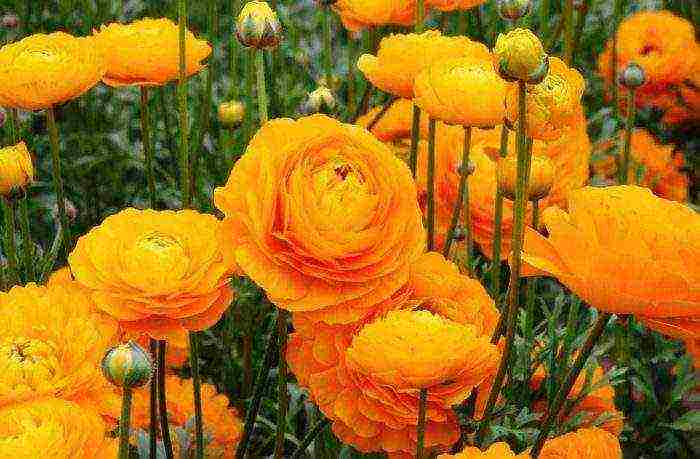
How to prepare the ground
Buttercup (garden ranunculus) can grow and thrive quite well in a sunny location, but shade works best for it. The fact is that there, such a flower retains a more saturated color of the inflorescences, while the duration of flowering increases markedly. Also, the buttercup should be protected from the influence of drafts. Such a plant does not tolerate sub-zero temperatures, in this regard, it should be planted only after the threat of frost has passed.
The soil for ranunculus is most suitable for light, neutral acidity and rich in nutrients. So, it can be peat or humus mixed with black soil. But it is imperative to add chalk to it to neutralize. You cannot plant such a flower on a site with loam. Remember that the soil should perfectly absorb water during irrigation, but it should not linger in it for a long time. In order to avoid the formation of rot, plants need good drainage. To do this, add, for example, a small amount of sand to the bottom of the planting pit. Before planting a buttercup, you need to dig up the soil, while adding compost to it. And also to cultivate the soil with a foundation.
What time is the sowing of seeds
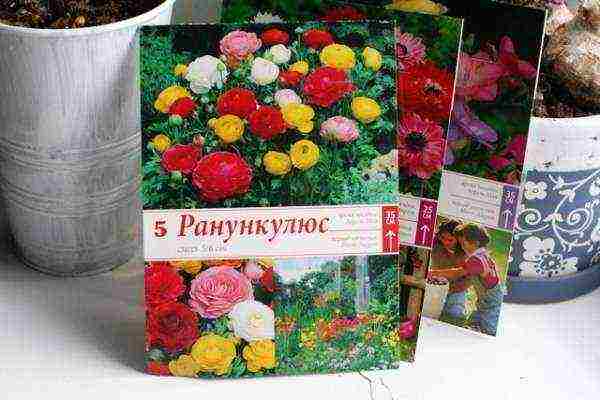
Growing buttercup from seeds is a rather difficult process, and all because they have a relatively low percentage of germination. Experienced gardeners are advised to collect seeds only from those flowers that have faded first. In order for the seeds not to spill out onto the surface of the soil, the inflorescences must be wrapped with gauze. Sowing should be done in mid-February. For this, a light substrate enriched with useful substances is used. After the seeds are sown, sprinkle them with a very thick (1.5 to 2 centimeters) layer of soil. On top of the container, you need to lay transparent glass or stretch the film. The container should be moved to a place with good lighting, where the temperature is within 15-17 degrees.If necessary, it is necessary to moisten the soil. The first seedlings should appear 14–20 days after sowing. When this happens, the cover should be removed from the container. When 2 pairs of true leaves grow, the ranunculus will need to be dived into individual pots. When the threat of frost passes in the spring, these flowers should be transplanted into the garden. Flowering will be observed only next year, so if you want to get a quick result, this method of reproduction of ranunculus is not suitable for you.
What time is the planting of tubers
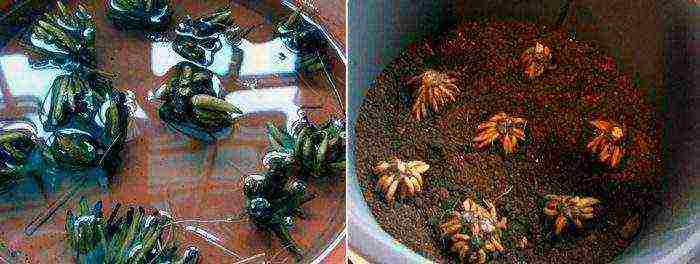
After the soil warms up and the frosts are left behind, you will need to plant buttercup tubers in open ground. As a rule, this time falls on the last days of April, the first - in May. Planting tubers is not difficult, but there are rules and tricks that should not be forgotten. Before planting tubers, they must be prepared. To do this, they are laid out in well-moistened moss, sawdust or on a moistened sponge. The tubers should sit for several hours. The same effect can be achieved by soaking in cold water or in a weak solution of potassium manganese. In some cases, it is recommended to add a growth-promoting substance to the liquid. Choose the most suitable place for such a flower at once, since it is not recommended to transplant it.
It is necessary to lower the tuber into the prepared planting hole with the "beak" down to a depth of 5 to 8 centimeters. It is necessary to maintain a distance of 10 to 15 centimeters between plants. In the event that frosts are expected, then the plantings should be covered with straw or special covering material. After 2-3 months, several peduncles will grow on each bush, and flowering will begin after some time.
Features of care in open soil

Taking care of such a plant is quite simple. It is necessary to moderately systematically water the ranunculus, but at the same time make sure that the soil does not become waterlogged, as in this case rot may form. You can find out that the flower has begun to rot by looking at the mold on the leaf plates and by the buds falling off. The affected parts of the flower should be cut off, the soil around it must be loosened and watering must be reduced by all means. Timely need to remove faded flowers, as they will prevent the flowering of other inflorescences. This plant needs regular loosening of the soil, and it must also be fed using organic fertilizers. So, 2 times a month, potash fertilizer must be applied to the soil (per 1 square meter from 40 to 50 grams of the substance), and during flowering, potassium sulfate, potassium salt or wood ash are suitable for this. A spider mite can settle on a buttercup bush (especially during a summer drought). Thrips and aphids can settle on leaves and shoots. When you see whitish or silvery spots on the foliage, then immediately take measures to destroy the pests. For this, the bushes must be treated with suitable insecticidal agents. For preventive purposes, ranunculus should be treated with a solution of mercaptophos (0.2%) 2 or 3 times a week.
How to care at home
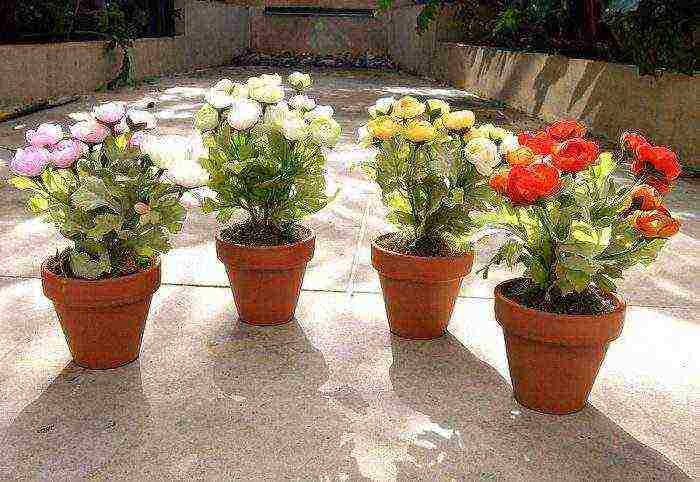
How to plant indoors
Taking care of buttercups growing on the balcony is also not difficult, as well as those that are grown in the garden. However, in order for the plant to grow and develop well, you should remember some rules and secrets. In indoor conditions, such a flower should not be grown as a single, therefore, it is recommended to plant several bushes in one pot at once. For planting, you can use both a decorative box and a fairly voluminous pot purchased at a store, in which there must be drainage holes on the bottom.For planting, you need exactly the same soil as in the garden, or rather, peat-based soil. The tubers should be immersed in water for 24 hours before planting. A good drainage layer should be laid on the bottom of the pot or box; expanded clay, crushed stone or egg shells are suitable for this. Then the earth is poured and nodules are laid out on its surface. They must be covered with soil in such a way that only the tops rise above the surface. With a sufficient volume of a flower pot, several nodules can be planted in it at once. Water well and remove for the first time in a cool enough place (about 12 degrees). Soil moistening should be carried out as necessary.
How to care
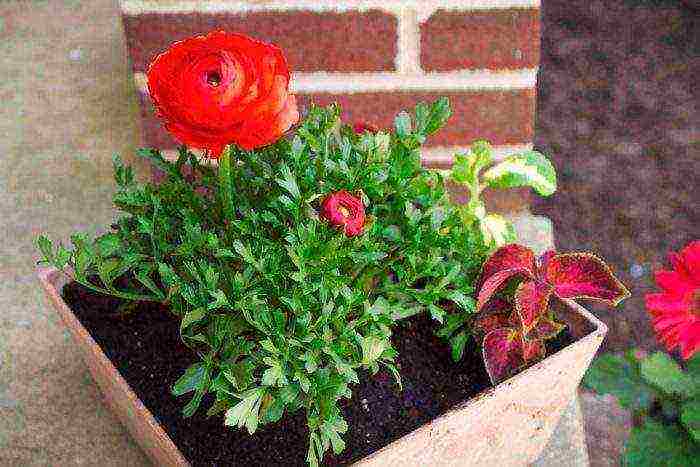
When the sprouts reach a few centimeters, the pot should be transferred to a warmer place (from 20 to 22 degrees). If you walk, enjoy the beautiful flowers of ranunculus as long as possible, then during the flowering period it should be provided with a temperature of about 18 degrees (not lower, not higher). Such a plant, grown indoors, needs direct sunlight. In this regard, it is recommended to place it on windows with western or eastern orientation. However, a southern window works best for a buttercup. When it is warm outside, then these flowers, if desired, can be placed in fresh air (balcony, terrace). They need systematic watering, while during intensive growth it is recommended to add fertilizers to the water. Watering is top, but at the same time try to avoid waterlogging of the soil. From time to time, you need to moisten the foliage with a sprayer. When the plant begins to wilt, it needs to be watered much less.
Ranunculus after flowering

How to dig up and store garden ranunculus tubers
The tubers are dug up in autumn. After the shoots and foliage turn yellow and dry, they are cut off, and tubers are dug out of the soil. It should be remembered that the rhizomes of such a plant are quite delicate and can easily break, so they should be dug out carefully. Such a perennial can die at temperatures less than minus 7 degrees, in this regard, it is recommended to store the dug tubers in a basement with good ventilation, where the temperature should be at a level of 4 to 6 degrees. In this case, the tubers must be wrapped with dry moss or put in a paper bag. Before removing the nodules for storage, they are processed in the foundation for half an hour, and after that they are allowed to dry well in a shaded place for about 3 days. Such a perennial plant in places with mild winters does not need to be dug out, they are simply covered with fallen leaves or spruce branches.
Caring for indoor ranunculus after flowering
After the ranunculus has faded, it must be removed to a shaded and cool enough place. The flower will grow for some time, and then it will have a dormant period, while the shoots and foliage will turn yellow and dry out. Transplant the flower into fresh substrate and transfer it to a place with a temperature of 15 to 18 degrees. The duration of the dormant period is about 4 weeks; young sprouts will appear already in April. During the period of intensive growth, each nodule has 5 to 7 young shoots. They are dug up and carefully separated. Then the tubers can be planted in individual pots, or they can be stored until spring on a refrigerator shelf in the vegetable section or in the basement. It must be remembered that weaker plants grow from such "preserved" nodules and their flower diameter is comparatively smaller. Most inexperienced growers therefore acquire fresh nodules every year.

